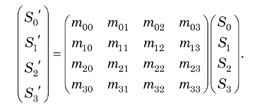Optipedia • SPIE Press books opened for your reference.
The Mueller Matrices for Polarizing Components
Excerpt from Field Guide to Polarization
In general, the polarization ellipse is in a nonstandard form. The polarization ellipse (polarization state) can be changed by changing the amplitude(s), the phase, or by rotating the ellipse. Polarizing materials are available to do this. A polarized beam with a given polarization state propagates through one or more polarizing elements, where the beam acquires a new polarization state. This process is represented in the following figure.

The input beam is characterized by a Stokes vector S and the output beam by S'. The assumption is made that S and S' are linearly related by a 4 × 4 transformation matrix known as the Mueller matrix, which represents the polarizing element(s):

All the elements in the 4 × 4 Mueller matrix are real quantities. The above matrix relation can be written as a matrix equation,

Only two polarizing elements are needed to change the three parameters of the ellipse (the orthogonal amplitudes and phase). The amplitude can be changed by using a polarizing element known as a polarizer. Similarly, the phase of an optical beam can be changed by a wave plate (also called a retarder or phase shifter). Finally, the polarization ellipse can be changed by rotation using a component called a rotator. Using these three polarizing elements, any elliptical polarization state can be obtained.
E. Collett, Field Guide to Polarization, SPIE Press, Bellingham, WA (2005).
View SPIE terms of use.

